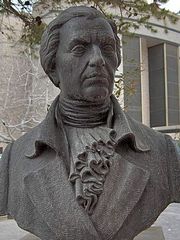This article is part of the series "A Moment in History" where we honor those who have contributed to the growth of medical knowledge in the areas of anatomy, medicine, surgery, and medical research.

Francisco Javier Balmis
The Balmis Expedition (1803 -1806) The “Royal Philanthropic Vaccine Expedition”, otherwise known as the "Balmis expedition" is a little known chapter in the history of the eradication of smallpox from this world.
One of the unintended consequences of the Spanish invasion of the New World and the work of the “Conquistadores” was the introduction of smallpox to a virgin population. Other viruses were also introduced, so that between smallpox, measles, rubella, etc. it is said that in 1520 almost 50% of the population of Mexico died because of a biological infection.
Edward Jenner (1749 – 1823) discovered in 1796 that someone infected with cowpox would be protected against smallpox. The vaccine and the expansion of its use brought some relief to Europe, but the damage caused by smallpox in the Spanish colonies was catastrophic. Smallpox in its more virulent variety carried at the time a mortality rate close to 30%, leaving those who survived the virus with skin pockmarks or blinded for life. It is estimated that towards the end of the 18th century, 400,000 people died in Europe because of smallpox, and one third of the survivors were left blind.
A solution was needed, so in 1803 the Spanish king Carlos IV commissioned Don Francisco Javier de Balmis i Berenguer (1753 – 1819), a Spanish phyisician, to find a solution to the smallpox problem. While planning what was later to be known as the “Royal Philanthropic Vaccine Expedition” Balmis received critical contributions from Don Antonio de Gimbernat y Arbós (of Gimbernat’s ligament).
The main problem to this expedition was that there was no refrigeration, and the vaccine production and storage as we know it today had not been invented. The procedure was simple: Inoculate the live virus of cowpox from someone who was infected with cowpox. The solution was brilliant. A group of 10 physicians and 25 orphaned children were recruited along with nurses, and having at least one infected child on board each ship, the expedition sailed on November 30, 1803. During the long voyage, child after child were sequentially infected with the smallpox virus so that four months later, on March 19, 1804, the expedition landed in Venezuela with a child with the virus.
From here, the same method was used to distribute the vaccine North and South, to cover all of the Spanish territories until 1810. The original expedition is known as the “Balmis expedition”, and Balmis returned to Spain in 1806. Other expeditions were named after other leaders (Salvany, Justiniano, Grajales y Bolaños, etc.) but all carried the original strain brought to the Americas by Balmis. Although the original 25 children were granted the title of “special children of the Spanish nation”, no one knows how many children were used in the end, or what was their eventual fate transplanted away from their homes.
The image in this article, courtesy of Wikipedia, is a bust found at the Medical College of the Miguel Hernandez University in San Juan de Alicante, Spain
Sources:
1. “La viruela, aliado oculto en la conquista española” Sanchez-Silva, DJ. INFORMED 2007; 9 (12) 581-587
2. “La expedición de Balmis” Laval ER Rev Chil Infect 2003; 107-108
3. “Antonio de Gimbernat, 1734-1816” Matheson NM. Proc R Soc Med 1949; 42: 407-10.
4. “La vuelta al mundo de la expedición de la vacuna (1803-1810)” Diaz de Yraola, G. (2003)
5. “La segunda expedicion de Balmis” Tuells, J.; Duro-Torrijos, JL G Med Mex 2013 (149) 377-84
Original image in the Public Domain courtesy of Wikipedia



